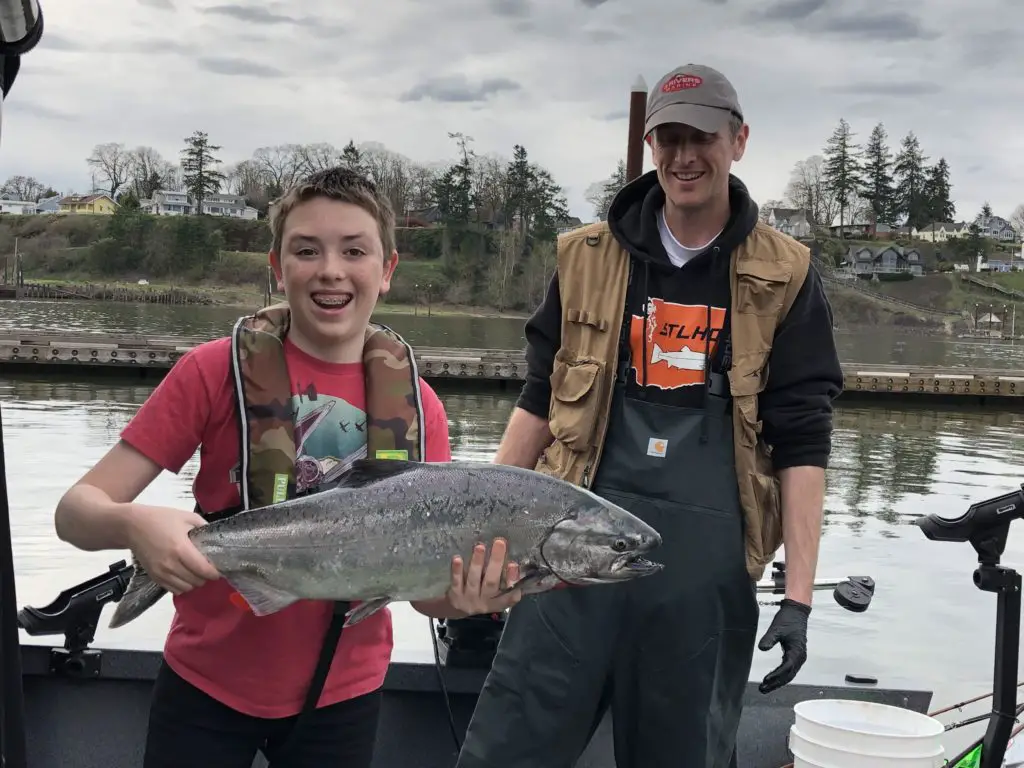
Columbia River Springers are the best tasting salmon on planet earth!
This entire page is dedicated to sharing and explaining how to fish for and catch these unbelievably fatty, tasty salmon.
Each year, we drive 3 hours from Pugetropolis to take part in springer fishing on the Columbia River.
I would say this is a world-class fishery, but for the low success rate and high competition to get these fish.
This is not a numbers thing with these fish. In fact, in my book, just one springer makes this trip worthwhile.
We fished for springers in 2019 during the restricted seasons and found success just above Warrior Rock trolling the Washington side.
We camped out on Sand Island Marine Park to make the most of our long drive down and got a springer both days.
We literally saw no other fish caught and kept and the fish checker had zero fish checked in as well, so we were pretty happy with our success.
There were also very few fish heading over Bonneville Dam at the time. We will talk more about the importance of that later in the article.
Latest Posts about Columbia River Springer Fishing
- Persistence pays off when fishing the Columbia River for Spring Chinook
- Preparing for the 2024 Columbia River Spring Chinook Fishing Season
- Columbia River Spring and Summer Chinook Salmon Forecast 2024
- Why you should fish Buoy 10 and our lessons learned
- 2022 Washington Coast Salmon Season
Techniques for Columbia River Springer Fishing
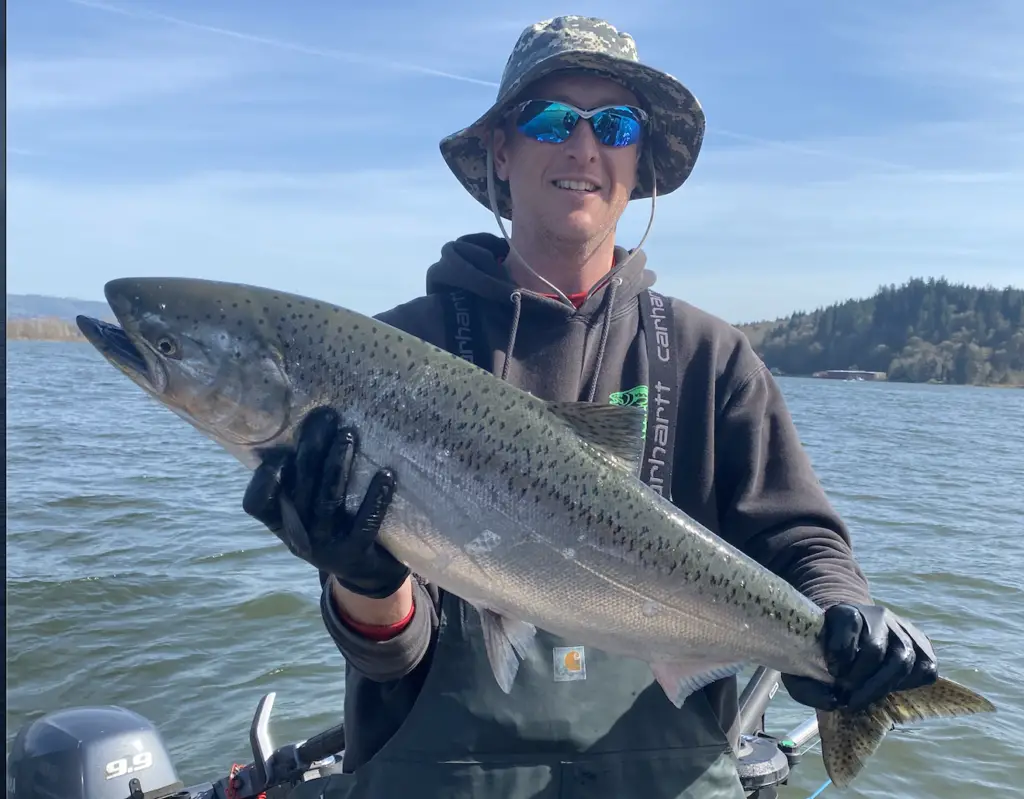
There are quite a few different techniques used to fish for Columbia river springers.
Anchoring or hog lining for springers with a variety of terminal presentations is quite popular anywhere on the river.
The way I learned to target springers though and what I’ve found success with, is trolling cut plug herring.
Trolling cut plug herring is what we will focus on for now in this article.
Some can get intimidated by the whole idea of cut plug herring.
If you’re a salmon spoon/hoochie downrigger trolling angler from up my way, it may seem a bit much, but I can assure you that it’s quite simple and easy to get the hang of.
As an Amazon Affiliate, I earn from qualifying purchases through these links, but the price you pay is the same regardless, so please support my blog by using these links. Thanks!
Buy a guide for cut-plugging herring. Use a sharp knife to make the diagonal cut right behind the gill plate.
Buy several trays of green label cut-plug herring.
We found that 3 dozen herring lasted for about 12 passes with 3-5 rods in the water.
You can certainly fish it by yourself, but your odds go up dramatically if you can drag your family (or fishing buddies) with you and legally fish those 3-5 rods.
For optimal family comfort (a big deal in April!), make sure the top is up on the boat, maybe deploy a space heater and lots of good snacks and drinks.
Take a few breaks to make some jetboil hot chocolate, mocha or whatever else.
A few other tips about preparing cut plug herring and fishing with them
After cutting the herring, I will place them in ziplock bags with about 1 cup of rock salt and 1 quart of water for about 2 dozen green label herring per bag.
I do this for basically about 8-12 hours or overnight to firm them up. I then empty the water/salt out, and leave them in Mike’s Brite n Tight blue or green for 24-48 hours.
The most important aspect of fishing this way is ensuring that the bait spins in a tight spin, like a drill bit when trolling as slow as possible with the current.
There are many many ways to put your plug-cut herring on your double hook rig. I was taught and use the most simple way imaginable and it works!
Take the top hook and find the backbone of the plug cut herring from the head end.
Don’t poke the hook through the backbone, just find it.
Now, move the point of the hook just slightly to the shorter side of the plug-cut herring and insert it all the way.
Leave the trailer hook to hang free. Make sure your trailer hook extends beyond the tail of the herring or you will have a problem.
When placing it in the water, you may need to gently pull the herring through the water to get it to start spinning.
If everything is done properly, it will continue to spin even at a very slow trolling speed.
Some herring just won’t spin for whatever reason, usually damaged or having been fished too long.
Just toss it at that point.
Trolling for Columbia River Springers
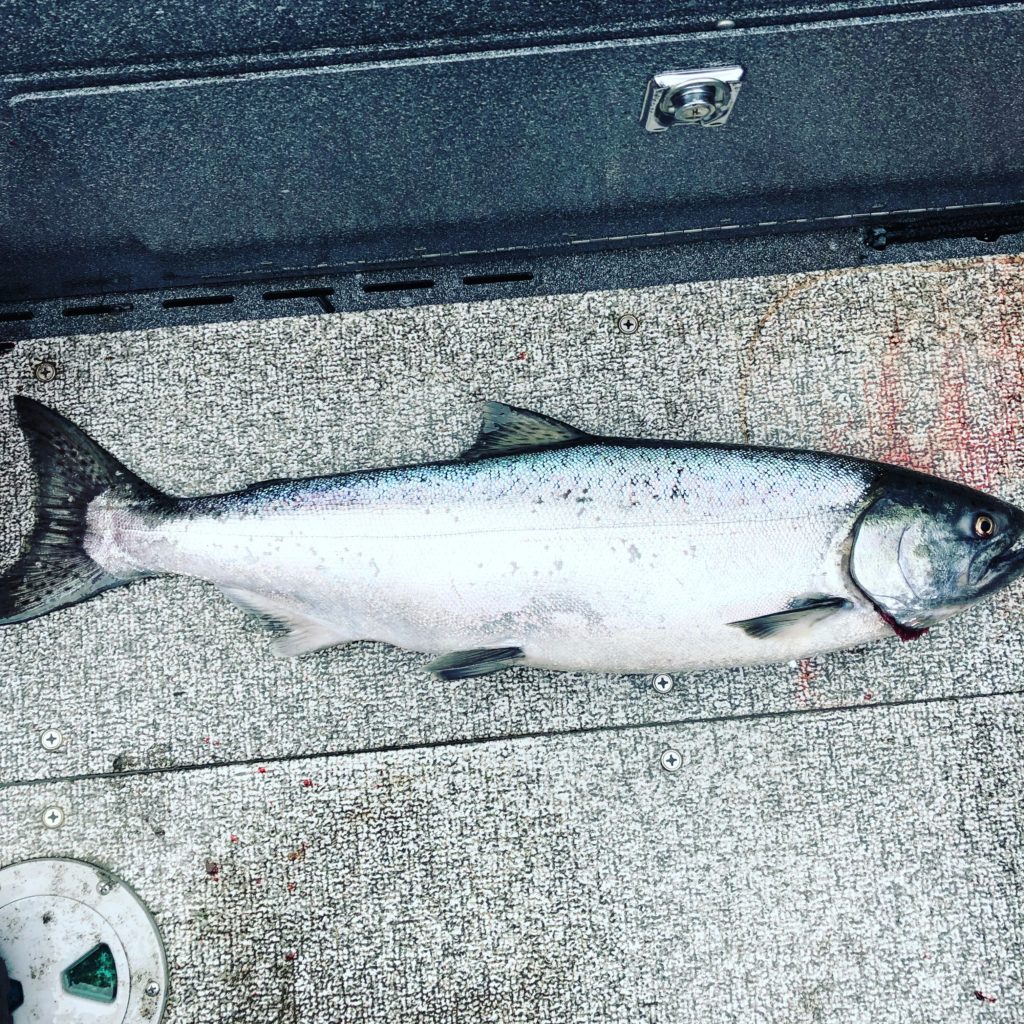
Make sure when you are trolling for springers on the Columbia River, that you stay outside of the hog lines and those anchored up on the river.
You don’t want to get your gear tangled in their anchor line or the lines they are fishing.
The entire time I troll with the current and the slowest speed my 9.9 hp kicker would allow.
We also fished with our gear right at/above the bottom in about 10-35 ft of water.
It’s super important to lower your gear to the bottom in a controlled way as it’s pretty easy to get it tangled if you go too fast.
We would get the gear to the bottom and then come up a crank or just enough to make sure the weight wasn’t dragging or bouncing constantly on the bottom.
The boat is constantly rocking due to the wake of other boats running back to the top of the troll, so on the trough of a wake wave, you can visually see if your cannonballs are hitting bottom or not by the action of the rod.
The rods should transmit that your cannonball sinkers hit bottom on the downswing of the boat rocking when another boat goes by creating a wake.
Another tip is when attempting to get 5 rods fishing at the same time, it’s important to use heavier weights 12-16 oz on the furthest outside rods to keep them right below the boat and not tangling with others.
I use lighter weights 6-10 oz (depending on depth) on the back rods so they will be further behind the boat.
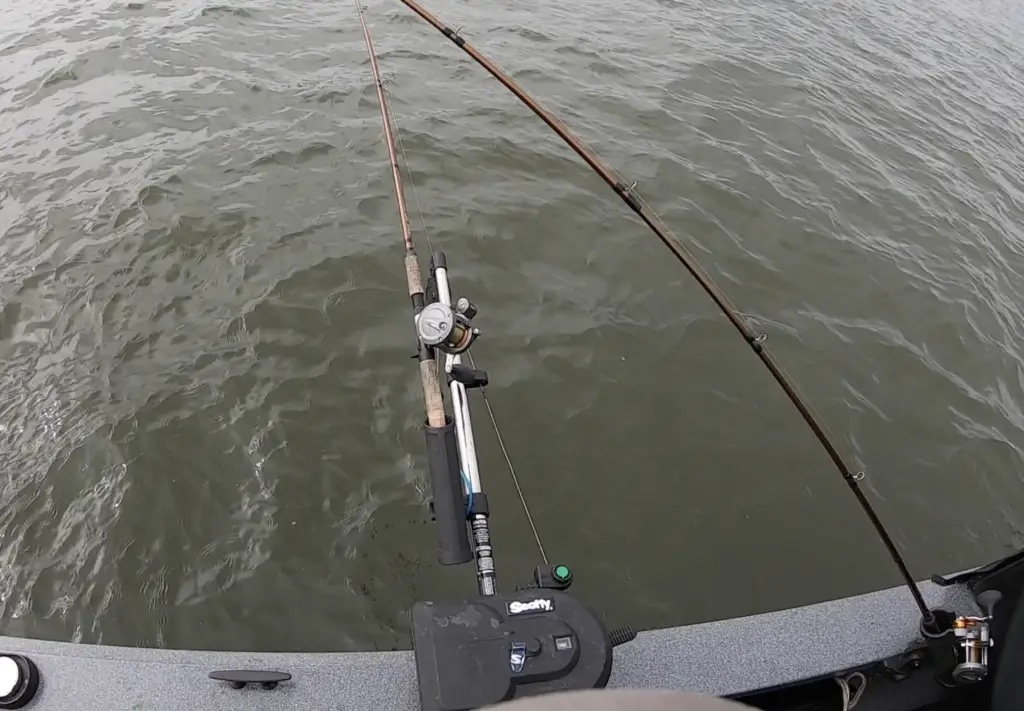
I only have 3 rod holders on the back part of the boat, so I always bring my downriggers and stick them directly out 90 degrees or perpendicular to my boat with the heaviest weights on those rods in the downrigger holders.
I then use the rod holders directly behind the downriggers (closer to the bow) and point them at a 45-degree angle toward the back.
This means that the rods crisscross, but this is not a big deal as long as you are paying attention when bringing them up.
Rigging up gear for Columbia River Springers
There are several variations of gear and lengths to mess with here, but I will explain what we do as a good starting point for anyone looking to just get going here:
- Start with a strong mainline of at least 30 lb. We use a 100-yard top shot of 30 lb Seaguar tied to 150 yards of 50 lb Powerpro braid with an FG knot.
- Before that we just had our Okuma Coldwater reels spooled with 30 lb mono
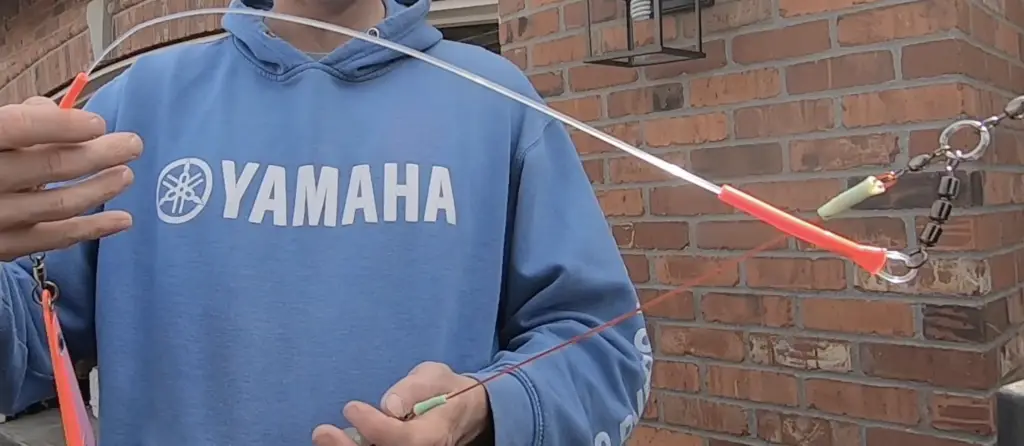
- Tie mainline directly to the snap swivel on these Coldwaterstrong bumper leaders we recently tested in 2021 (with great results!).
You can take a look at this video for more on using the bumper leaders. There are other bumper leaders out there, but so far we’ve only used the ones from Coldwater Strong.
- We then connect the dropper line to a cannon ball lead weight from 6-12 oz.
- Connect the longer end of the bumper leader to a fish flash.

- Tie a 6-10″ section of 30 lb mono from the fish flash to bead chain swivel
- Use a 25 lb fluorocarbon line as leader material to cut plug herring about 48″ long.
Planning a trip for Columbia River Springers
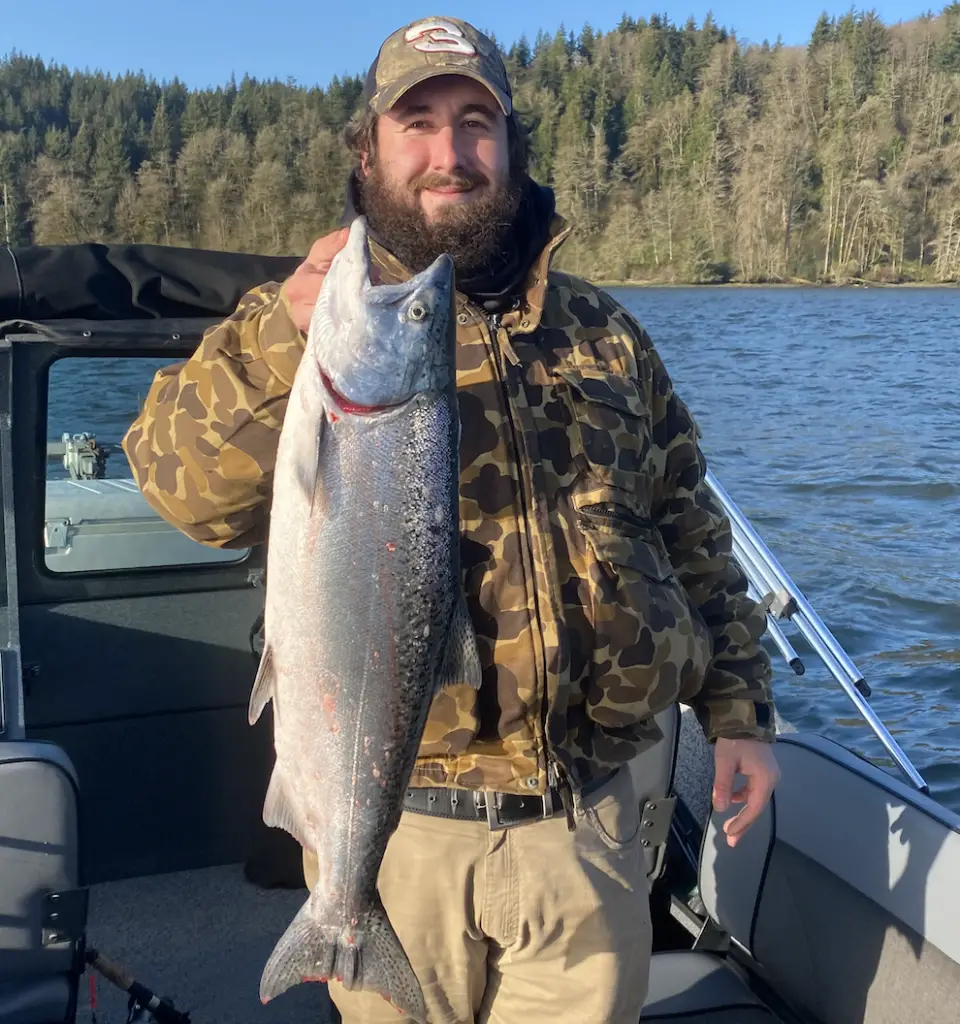
OK, so you have an idea of what gear you need for springers, a few ideas on techniques, and what to do about bait / cut plugging herring.
So what are you waiting for?! Go fishing! Wait…hold up. How do you know when to go? How do you plan for this if it’s 2-3 hours away?
There are three indicators you need to pay attention to, to decide when to go fishing for Columbia River Springers.
The first is the water temperature in the Columbia River. If you are like me you are already refreshing this link daily to watch the temperature go up with the warming weather.
I may also have a 10-day forecast bookmarked for parts of eastern Washington, but who’s judging, right? Right.
You want to see that temperature gauge go above 45 degrees to really have a decent shot at springers. Above 50 is party time.
Second, you need to pay attention to how many fish are headed over the dams.
This is a latent (24 hour+) indicator as to how many fish are in the river that you will be fishing for.
Ideally, you want 100+ fish per day going above Bonneville. Last year, by the time that was happening, the season was already over.
When we got our springers in 2019, there were only 10-15 fish per day going above the dams. This year, I don’t plan to wait for 100, but I would like there to be at least 25+.
I’m probably lying to you as I would likely go fish it with only 1 springer going over the dam, but you won’t think less of me right? Right.
In 2021 there were 1-15 springers per day and that produced some decent fishing on the lower sections of the river especially.
Lastly, if the previous conditions align, but the river is turbid and visibility is a few inches…you are likely going to waste some gas and time.
This can easily happen as the season stretches into April and you start to get all that freshwater influx and snow melt. Take a look at the flow rate and turbidity gauge here.
Numbers below 10 are pretty good clarity. I fished it at 30 once and that was a mistake. You can also look at the flow rate.
Flow rate going up dramatically usually also brings low water clarity.
Lastly, keep in mind that the entire river up to the Bonneville Dam is tidal influenced. Yes, even a hundred miles away from the ocean, the effects of tide cycles will have an effect on river currents.
The current will really rip when aligned with ebb tides, and it will slow down dramatically when backed up due to flood tides.
There are so many influences to current on the Columbia River though, that I would say it’s almost a mistake to try and plan a trip this far up the river purely on tides.
Just realize you will see their effect. We hooked most of our fish with the current moving a bit as the fish tend to swim and be concentrated near the bottom when there’s a current.
I’ve also hooked more fish with the current not ripping like crazy as you can troll slower and give a springer a little bit more time to decide to bite before your herring screams past.
So you want some current, but not too much. You can also read more about our 2019 trip fishing for springers on the Columba river here.
In 2021, fishing near Cathlamet, we had our best success near the flood tide when the current was slower or going upriver. There was a surge of springers that came through timed with the flood tide.
What kind of reel do you recommend for plunking off the bank?? For salmon or steelhead
If you can cast a casting reel I really like this one: https://amzn.to/3zbaHrd
I use my bank plunking reels/rods as boat / trolling rods too, so that’s what I use.